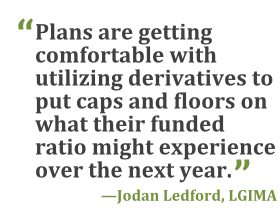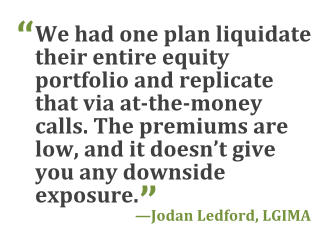 In 2013, the funded status improved dramatically for most pension plans in the United States. Still, many analysts expect pension de-risking to continue this year. Some plan sponsors will likely offer lump-sum buyouts to participants. Others are reconsidering their asset allocations.
In 2013, the funded status improved dramatically for most pension plans in the United States. Still, many analysts expect pension de-risking to continue this year. Some plan sponsors will likely offer lump-sum buyouts to participants. Others are reconsidering their asset allocations.
To get a handle on current trends in pension plan risk management, Treasury & Risk sat down with Jodan Ledford, head of U.S. solutions for Legal & General Investment Management America (LGIMA), a Chicago-based firm that manages fixed-income solutions for institutional investors. The organization also helps plan sponsors implement liability-driven investment (LDI) strategies, which focus on investing plan assets in vehicles that will optimally mitigate the risks inherent in the plan's liabilities.
T&R: First of all, what trends did you see in U.S.-based companies' pension plans in 2013?
Jodan Ledford: The biggest trend, obviously, was the funded ratio improvement. But we saw other trends as well. Being on the front lines of LDI, we saw strong flows into more long-duration corporate fixed income. As plans became better-funded, they started reallocating from what we typically call 'return-seeking assets' into more 'liability hedging assets.' We saw more clients moving down their glide path. That was pretty consistent throughout Q3 and Q4 of 2013.
T&R: When you use the term 'glide path,' does that refer to establishing guidelines for shifting asset allocations based on the plan's funded status?
JL: That's correct. It effectively means reallocating between return seeking and liability hedging to achieve the plan's objectives; the glide path really depends on what the plan's end-state goal is. For example, the typical closed and frozen plan, a plan that the company really has no desire to keep in its balance sheet, would be looking to glide into a 115 percent funded status on a GAAP [Generally Accepted Accounting Principles] basis to try to effect a risk transfer. So it would want to customize the amount of return-seeking assets it holds at each step along the way.
Another trend we saw in 2013 was that as plans became better-funded and hit a 90 percent funded ratio on a GAAP basis, a lot of them started to become interested in customized solutions. They're looking to mark their liability-hedging assets against the actual liability return versus just the return of a Barclays index. At the beginning of 2013, when most plans were somewhere around 75 percent funded, plan sponsors' first-order concern was to get longer durations. They were looking to invest in assets that would have roughly the same duration as their liabilities. They started moving into longer-duration fixed-income assets. Then, as they reallocated out of equity risks, their first-order concern became refining their liability-hedging assets so that they would move more in line with the liabilities. They started looking at making sure their liabilities' sensitivities to changes in interest rates aligned with their assets' sensitivities to changes in rates. Not only that, but they also started looking at potentially implementing options-based strategies that sell away upside to protect even further on the downside. By the end of last year, we were having a lot more discussions about derivatives implementation.
T&R: So companies are looking to get a lot more precise with the assets they choose to hedge risks in their liabilities?
JL: Yes. I'll give you an example. One of our clients is close to 100 percent funded. It's a smaller company, with about a $300 million plan, and they really want to focus on reducing funded-ratio volatility. We worked with them to sculpt their asset allocations such that they have a 20 percent exposure to return-seeking assets, while 80 percent of their assets are selected for liability hedging. To mitigate their funded-ratio volatility, we worked with them to cover as much of the interest rate risk within their liabilities as possible. Then we looked at the other liability risk, which is changes in credit spreads, but we were mindful of the fact that changes in credit spreads can correlate with changes in equities, especially in down markets.
So we worked with that plan sponsor to target a 100 percent interest rate hedge ratio and a 60 percent credit spread hedge ratio. What that means is, over the quarter, we wanted to match the liability return with respect to changes in interest rates, dollar for dollar. So if the liabilities change by $100 solely due to interest rates, we want to have a $100 return from our customized portfolio. And also, in conjunction with that, we want to match 60 percent of the change due to credit spreads. So if credit spreads widen and liabilities go down by $50, we'd want to have a $30 loss in our hedging portfolio.
The idea is, when you actually decompose how the liabilities changed over the quarter with respect to each of the risk factors, and add those up, you'll get the dollar return amount you're looking for. Then if you use that dollar return against your beginning-of-period value for liabilities, you'll have a liability benchmark of X percent. That's what we're trying to match when we talk about a customized portfolio.
T&R: What do you see 2014 holding for pension plan sponsors?
JL: We're seeing a lot of plans hovering around a 90 or 95 percent funded ratio. We're seeing a very large uptick in customized solutions. Plans are also getting much more comfortable with utilizing derivatives to put caps and floors, if you will, on what their funded ratio might experience over the next year. A lot of that is due to the fact that everybody thinks rates are going up at some point, as well as worries about the fact that equities have increased 40 to 50 percent over the last couple of years. We're seeing a lot of companies selling away the upside on rates, to use as a premium they can collect to finance the downside protection on equities. So we're seeing a lot more discussions about optionality and how that might fit into a glide path framework based on the plan's goals and objectives.
We're also seeing a lot more pickup in what's termed a 'completion manager framework.' What that means is, as plans move down the glide path, if they're putting more money into liability hedging, they typically won't use just one manager. If you're a $4 billion plan, you don't want one manager managing $2 billion of your assets. So typically a company will use four managers, and the fourth manager in will be a completion manager. Their job is basically to take the benchmark risk exposures of the other managers and then complete to the liability exposures in the aggregate. So they're turning the whole hedging portfolio, again, into something that matches the liabilities.
T&R: So, how are plan sponsors using options to manage risks in their pension portfolios? What does that look like?
JL: When it comes to protecting equities, we've seen companies implementing options strategies in two ways. The typical way is to buy puts or implement a put spread on the downside. But we've also seen companies starting to get comfortable with buying at-the-money call options. So they would have just upside exposure, and their downside would be relegated to the amount of premium they spent to put the calls on. We had one plan liquidate their entire equity portfolio and replicate that via at-the-money calls. We've only seen one plan go all the way to liquidating their entire equity portfolio, but at-the-money calls have come into vogue because the premiums are low and it doesn't give you any downside exposure should equity markets fall.
T&R: Do you see any hesitation about using derivatives in a pension portfolio?
JL: People are fairly comfortable in understanding how derivatives fit into their risk management frameworks. They're increasingly seeing that derivatives aren't purely instruments of speculation. We've seen a lot of education among plan sponsors in the past few years about how asset risk can speak to liability risk.
T&R: Do you anticipate that pension plan de-risking will continue to gather steam in 2014?
JL: Yes, I think it's here to stay. You'll still have some holdouts. There are plans that are going to want to remain open because they have a strong value proposition from an HR perspective. Those plans will not fully adopt LDI. But I think when you start looking at the regulatory side of things—you look at the fact that we're now on our second set of PBGC premium increases in the last five years or the fact that they're kicking around more conservative mortality tables that might increase liabilities carried on a GAAP basis by 7 to 10 percent—these kinds of surprises are starting to make more and more plan sponsors really interested in programs like lump-sum windows or pension risk transfers. So I think we'll see more de-risking in 2014, and I think more companies will be focusing on exit strategies to divest themselves of liabilities they don't want to carry anymore.
© 2025 ALM Global, LLC, All Rights Reserved. Request academic re-use from www.copyright.com. All other uses, submit a request to [email protected]. For more information visit Asset & Logo Licensing.




